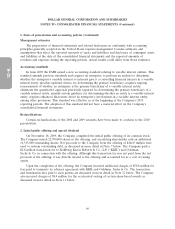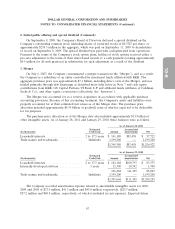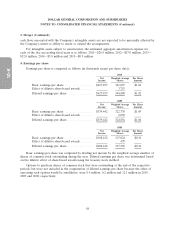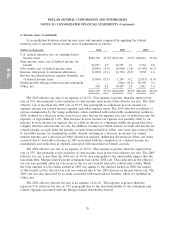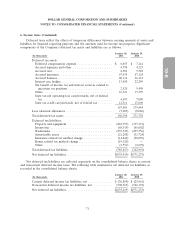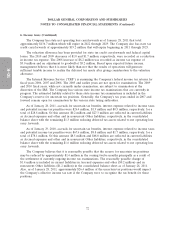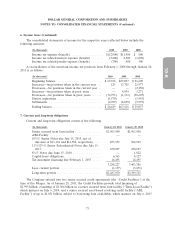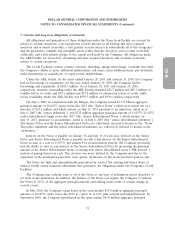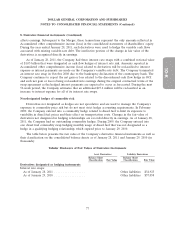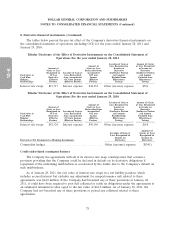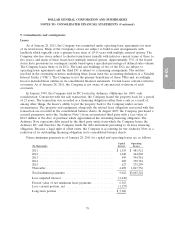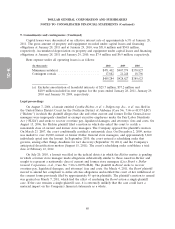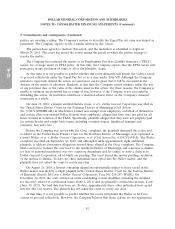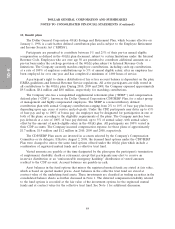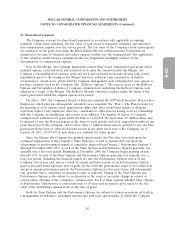Dollar General 2010 Annual Report Download - page 154
Download and view the complete annual report
Please find page 154 of the 2010 Dollar General annual report below. You can navigate through the pages in the report by either clicking on the pages listed below, or by using the keyword search tool below to find specific information within the annual report.
10-K
DOLLAR GENERAL CORPORATION AND SUBSIDIARIES
NOTES TO CONSOLIDATED FINANCIAL STATEMENTS (Continued)
7. Current and long-term obligations (Continued)
amount of 10.625% senior notes due 2015 at a price of 110.75% plus accrued and unpaid interest. The
2010 repurchases resulted in pretax losses totaling $14.7 million. In connection with the Company’s
November 2009 initial public offering, as further discussed in Note 2, the Company repurchased
$195.7 million of the Senior Notes and $205.2 million of the Senior Subordinated Notes at redemption
prices of 110.625% and 111.875%, respectively, plus accrued and unpaid interest, resulting in pretax
losses totaling $50.6 million. In January 2009, the Company repurchased $44.1 million of the Senior
Subordinated Notes, resulting in a pretax gain of $3.8 million. Pretax gains and losses associated with
the redemption of the Notes are reflected in Other (income) expense in the consolidated statements of
operations.
The indentures contain certain covenants, including, among other things, covenants that limit the
Company’s ability to incur additional indebtedness, create liens, sell assets, enter into transactions with
affiliates, or consolidate or dispose of all of its assets.
Scheduled debt maturities, including capital lease obligations, for the Company’s fiscal years listed
below are as follows (in thousands): 2011—$1,157; 2012—$707; 2013—$292; 2014—$1,963,815; 2015—
$864,787; thereafter—$468,630.
8. Derivative financial instruments
The Company is exposed to certain risks arising from both its business operations and economic
conditions. The Company principally manages its exposures to a wide variety of business and
operational risks through management of its core business activities. The Company manages economic
risks, including interest rate, liquidity, and credit risk, primarily by managing the amount, sources, and
duration of its debt funding and the use of derivative financial instruments. Specifically, the Company
enters into derivative financial instruments to manage exposures that arise from business activities that
result in the receipt or payment of future known and uncertain cash amounts, the value of which are
determined primarily by interest rates. The Company’s derivative financial instruments are used to
manage differences in the amount, timing, and duration of the Company’s known or expected cash
receipts and its known or expected cash payments principally related to the Company’s borrowings.
In addition, the Company is exposed to certain risks arising from uncertainties of future market
values caused by the fluctuation in the prices of commodities. From time to time the Company has
entered into derivative financial instruments to protect against future price changes related to
transportation costs associated with forecasted distribution of inventory.
Cash flow hedges of interest rate risk
The Company’s objectives in using interest rate derivatives are to add stability to interest expense
and to manage its exposure to interest rate changes. To accomplish this objective, the Company
primarily uses interest rate swaps as part of its interest rate risk management strategy. Interest rate
swaps designated as cash flow hedges involve the receipt of variable-rate amounts from a counterparty
in exchange for the Company making fixed-rate payments over the life of the agreements without
exchange of the underlying notional amount.
The effective portion of changes in the fair value of derivatives designated and that qualify as cash
flow hedges is recorded in Accumulated other comprehensive income (loss) (also referred to as ‘‘OCI’’)
and is subsequently reclassified into earnings in the period that the hedged forecasted transaction
76


